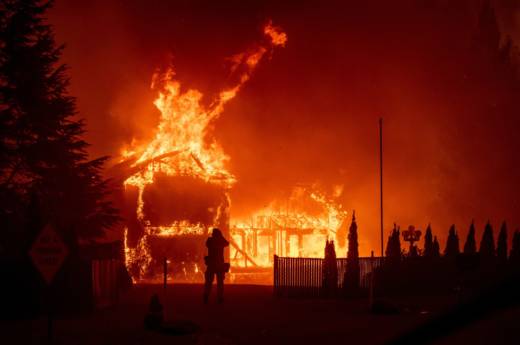Miller noted that this actually channels an ongoing conversation happening at KQED about using the phrase, “the new normal.” That phrase, he said, “misses the point.” There is no normal when it comes to climate change, or rather we don’t know what the normal is when we try to plan. It’s not just a steady move toward hotter and drier, but rather wild swings in all directions, creating more intense and changing conditions.
Ask the Right Questions
Are these fires definitely a result of climate change?
Swain says that’s not the right question. Generally, it never makes sense to attribute a single cause to complex natural events. “It’s a really hard thing to do from a scientific perspective,” he said. Multiple factors lead to a particular fire at a specific time and location. The broader question is: are wildfire disasters of this magnitude significantly more likely due to the fact that the climate is changing? “The answer to that is definitely yes,” said Swain.
This risk-based approach makes more sense for how we frame these issues and how we plan for disasters — by asking what is the likelihood of increasing dangerous conditions? And that likelihood is absolutely going up, according to Swain and most other scientists who have studied the matter.
Longer Fire Season, Shorter Rainy Season
Although autumn precipitation in California tends not to be a large portion of the overall amount of rain in a given year, it has an out-sized influence on fire season, said Swain. Early-season rain, at the end of a hot, dry summer, is “really consequential from a wildfire and an ecological perspective,” he said. Even just one or two inches moistens the soil column and lets the dry vegetation recover.
That rain usually marks the end of fire season and this year, almost up to Thanksgiving, as the Camp and Woolsey Fires were raging north and south, that fire-season ending rain had yet to fall anywhere in the state.
“That’s really, really late,” said Swain.
There is an emerging trend toward drier autumns throughout the state, which Swain expects to continue. He expects, in the future, to see a further contraction of the rainy season, not necessarily less rain overall, but longer dry conditions into fall and dry conditions beginning earlier in the spring, essentially “burning the candle at both ends,” as he put it.
Another reason autumn precipitation is important is because offshore winds peak late in autumn (not just the legendary Santa Ana winds of Southern California, but all up and down the state). If the rainy season comes later and later, with months of drying time, peak fire season could shift to later in the year, when these strong winds occur. Both the Camp Fire and the Woolsey Fire were driven by strong winds.
California’s Getting Warmer and Drier
As the climate warms, it has a profound effect on how much moisture is in the vegetation. There’s something called the vapor pressure deficit, which is the propensity of warmer atmospheres to suck water out of living plants. This increases exponentially even as temperatures go up in linear fashion. That means even a few degrees increase in the temperature can make the vegetation much drier and more susceptible to fire, particularly if the dry vegetation coincides with a longer warmer fire season and the strong late-autumn winds.
All of these factors combine to increase the chances of dangerous fire conditions.
Is There Hope?
The California’s recent Fourth Climate Change Assessment projected that, if greenhouse gas emissions continue to rise, the state could see large fires increase by half and the total acreage burned increase by about 77%.
“We’re already starting to see this play out right in front of us,” said Miller. Swain took that pessimistic prediction a step further, noting the current fire situation is merely a hint of what’s to come.
“We’re only just beginning this trend towards longer fire seasons, more severe fire seasons, hotter summers, wilder precipitation whiplash,” said Swain, the last a reference to seasons that whipsaw from wet to dry, or vice versa.
There are also a large number of people who have moved into areas that are at risk. Across the U.S., said Miller, there are 100 million people living in what’s known as the wildland-urban-interface — areas just like Paradise that exist on the edges of rural forests and remote wildland. This means there are more people than ever before in harm’s way, setting the stage for more catastrophic fires.

